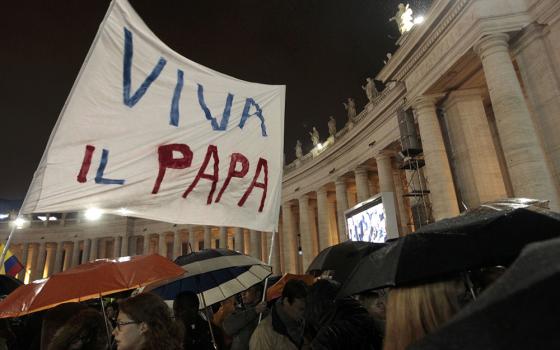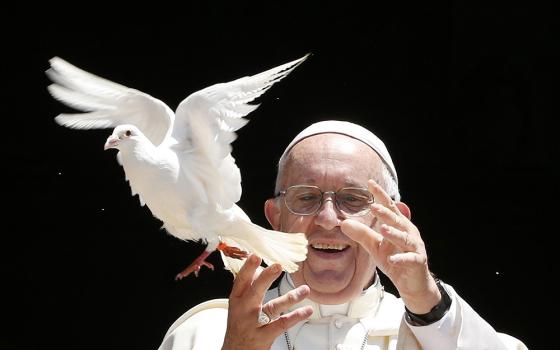This is a collection of tombstones at Calvary Cemetery in East Los Angeles that date from the 1940s — proof of how beloved Santo Niño de Atocha was even back then. (Courtesy of Gustavo Arellano)
God seems far, far away from the HBO limited series "Perry Mason." Set during the Great Depression, it's everything a noir should be. The rich are evil; the poor, just barely hanging on. Discrimination and vice are everywhere. Its heroes are flawed. Justice is not part of the natural order but rather something humans must finagle out of chaos — if it's even reachable.
But where God doesn't dare tread in the reimagined world of Erle Stanley Gardner's legendary fictional lawyer, the Santo Niño de Atocha does.
He's an image of the infant Jesus, originally venerated in Spain during the Moorish occupation, then brought over to Mexico during the conquest. Santo Niño de Atocha is the patron saint of the wrongfully accused, whom he symbolically nourishes with the basket of bread and the water gourd in his hands. He's also a pilgrim, as evidenced by his walking stick, wide-brimmed hat, humble sandals and the scallop shell pinned to his cloak — that's a memento for those who finish El Camino de Santiago.
Santo Niño de Atocha is one of the most popular Catholic images for Mexican Americans — chapels built in his name date back to the 1850s in New Mexico. But it's Los Angeles that holds him closest, and "Perry Mason" offers the briefest, but most telling, testament to this unappreciated part — for outsiders, at least — of Angeleno life.
Advertisement
The second season of the show centers around Rafael and Mateo Gallardo, two Mexican American brothers accused of murdering a prominent, corrupt businessman. During one scene, Mateo's wife tells him how his Aunt Luisa has everyone in their barrio praying to Santo Niño "10 times a day."
Mateo smiles when he hears this. "That's only two more times than she normally does," he replies.
It's a blink-and-you'll-miss-it-moment, but that's what makes the cameo so profound. The veneration toward Santo Niño de Atocha in L.A. is so strong, the creators of "Perry Mason" implicitly say, they don't even have to dwell on it.
They could have easily gone with a Catholic figure Americans are more familiar with, like the Virgin of Guadalupe, or even just a general reference to Jesus. But all credit to Santo Niño de Atocha's shoutout goes to Natalia Molina. She's a University of Southern California professor of American studies and ethnicity and MacArthur genius winner whom "Perry Mason" hired to ensure they accurately replicated Mexican life in Los Angeles during the Great Depression.
In a recent Los Angeles Times essay, Molina said she included the Santo Niño de Atocha because it was a favorite patron saint of her grandmother. But I think the good profe is underselling her research chops. Faith and family aside, she knows that even in the 1930s, when Los Angeles was one of the whitest, most Protestant big cities in the United States, the Santo Niño de Atocha already mattered.
A statue of Santo Niño de Atocha is pictured in the Los Angeles Times office. The statue is now in Gustavo Arellano's personal library. (Courtesy of Gustavo Arellano)
The earliest reference I could find of him in the city dates to the April 30, 1915, edition of "The Tidings," the longtime newspaper of the Archdiocese of Los Angeles (it now goes by Angelus News). A short article noted that children at Our Lady of the Angels in downtown L.A. — popularly known as La Placita, and one of the oldest Catholic parishes in Southern California — were going to do their First Communion and carry a new statue of what the paper called the "Holy Infant Jesus of Atocha" during their consecration. A few months later, a sodality in his name was formed at La Placita for boys. Nine years later, the paper reported on a vigil in Orange County held by the Romero family to "fulfill a promise made when Mr. Romero's life was in grave danger, and who was saved as soon as the promise was made."
In the span of that time, hundreds of thousands of Mexicans had moved to Southern California — first, because of the Mexican Revolution, then because of the Cristero Revolt during the 1920s, when an increasingly secular Mexican government declared war on the Catholic faithful. Many came from Zacatecas, the central Mexican state where a shrine to Santo Niño has stood in the mining town of Plateros since the 19th century. Los Angeles Bishop John Joseph Cantwell took care to ensure that the customs of the new parishioners were respected and fostered — and Santo Niño de Atocha quickly took hold.
Catholic gift shops in the city began to sell images of him as early as the 1930s. Students dressed in his outfit for parish costume contests. The archdiocese organized pilgrimages to Mexico to see not only the Basilica of Our Lady of Guadalupe in Mexico City, but also the Santo Niño de Atocha's shrine in Plateros. He was the patron for a 1955 March of Dimes parade in Olvera Street, the birthplace of Los Angeles. Statues of him were placed in the chapels of L.A.'s new parishes, especially after the next big wave of Mexican migrants in the 1960s, which included my zacatecano parents.
Santo Niño de Atocha has been a constant part of my life, and not just in my home. His image is as much a part of the Southern California landscape as palm trees and sunglasses.
Santo Niño de Atocha has been a constant part of my life, and not just in my home. His image is as much a part of the Southern California landscape as palm trees and sunglasses. Votive candles with him are constantly stocked in supermarkets. Bumper stickers with his silhouette adorn cars; prayer cards are affixed to refrigerators and cubicles, or are stashed in wallets. Whenever a replica statue of Santo Niño de Atocha visits Southern California from Plateros, hundreds of thousands of pilgrims come from across the country for processions, vigils and Masses.
His L.A. ubiquity explains previous showbiz turns in the cult film "Napoleon Dynamite," the ABC sitcom "George Lopez" and even the music video for Michael Jackson's megahit "Beat It." Santo Niño de Atocha was even embroiled in political scandal in 2020, when ex-L.A. councilmember José Huizar — who was born in a Zacatecas village in between the hometowns of my mom and dad — posted an image of him on Instagram just hours before the FBI arrested Huizar on bribery charges he would eventually plead guilty to.
Between all that and his "Perry Mason" mention, Santo Niño de Atocha should probably get an agent soon.
I especially love Santo Niño's HBO turn because it's also a metaphor for his unlikely staying power in a city that loves its flash, even in the religious realm. He isn't clothed in regal garments like Our Lady of Juchipila or the Virgin of San Juan de los Lagos, two Marian apparitions with big devotions in the City of Angels. Santo Niño de Atocha doesn't wear a medallion like St. Jude Thaddeus, or inspires colorful celebrations like Dia de los Muertos.
Yet that humility is what makes him so beloved and perfect for Los Angeles. In a city where hopelessness lurks at every corner and it's getting harder and harder to afford anything, he walks among us and guides us, and reminds us that God is always with us — especially when and where we don't think he is.






